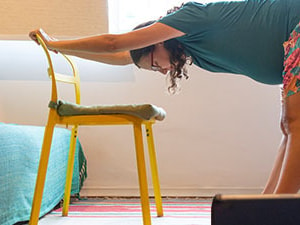3 Quick Tech Tips for Your Next Telehealth Session
June 1, 2021
6 min. read

As clinicians, we are all looking for ways to improve our patient interactions when using telehealth. For some, harnessing the many options offered by this emerging technology may be intimidating. But technology doesnt have to be a barrier to using telehealth successfully.
Whether you are new to telehealth or simply interested in advancing your use of this technology, these quick and simple tips can improve your experience and your patient outcomes.
1. Subjective Exam: Improve Your Gaze Angle
Postural mirroring, head nodding, leaning forward, and exaggerating expressions are all well-documented ways to improve patient communication, and they can be done easily in both in-person and remote settings.1,2,3 However, when it comes to eye contact, there are major differences between these settings.
In an in-person setting, it is simple: You just look into the patient's eyes. But during a virtual visit, the patients eyes are your webcam. So when you are smiling and looking at the patients image on the screen, what the patient sees is a clinician not making eye contact. Although this is a common clinician error, there is an easy fix.
The solution is to have where you look (the patients image) be as close as possible to the patients eye (the webcam). Have you ever wondered why a webcam or smartphone camera commonly attaches to the top of the screen and not the bottom or the side? It has to do with the gaze angle. Rotating your eyes down is less noticeable than rotating them up or to the side.4 During a telehealth visit, the ideal gaze angle is less than seven degrees. When the gaze angle is greater than seven, your patient may feel that you are not making eye contact.5
This short video offers some quick suggestions to improve your eye contact with a patient.
If the angle from your camera lens to the eyes of your patient is greater than seven degrees, the patient will perceive that you are not making eye contact. Fortunately, you can improve this by:
Asking the patient to move closer to the screen
Asking the patient to tilt down their screen to minimize the space above their head
Making the patient's video feed smaller on your own screen
Moving the patients video image to the top of your screen, directly below your webcam
Moving your chair farther away from the screen (you can zoom in on the image if needed)
Following these suggestions creates a shorter distance between the patient's eyes and the webcam, allowing the clinician to maintain better eye contact.
2. Objective Exam: Quantify Your Range of Motion
How can you guide a patient through range of motion in a remote environment? Here is a quick recap of the steps necessary to ensure you are collecting data correctly:
Expose the region
Orient in the desired plane
Clear baseline symptoms
Instruct the patient in the motion
Correct for any compensations
Measure the range of motion
Compare to the opposite side
Patient can add self-overpressure in PROM (if possible)
Document findings
Share with patient
Since you are not able to use tactile cueing to guide the patient into the correct motion, it may be a challenge to have the patient achieve the proper position. Having a visual resource available for patients to reference while you are performing a range-of-motion assessment will help.
The following download can be printed and provided to your patients to show them the most common range-of-motion testing positions:
Jared Vagy Range of Motion Handout
Unlock your free handout on common range of motion testing positions.
Unlock Resource
Once the patient performs the correct motion, you will need to quantify the range. There are several methods of obtaining range-of-motion values remotely; some are easy to perform and some require more technical expertise.6,7,8,9
One way to measure range of motion during a telehealth visit is to use a goniometer or inclinometer (or another secondary device) and hold it against the image on the screen. This allows you to measure the range of motion using the same tools used in an in-person visit.
You can also measure range of motion with digital internet goniometry by using onscreen devices provided in the telehealth platform you are using or in extensions in your web browser. These virtual tools can be moved about the screen and adjusted to match the tools angle with the patients image.
One particular study I find quite helpful is a systematic literature review of eleven articles by Suresh Mani and colleagues. This review indicates that both on-screen and digital internet goniometry have good-to-excellent concurrent validity as well as intra and interrater reliability.10
Using an on-screen goniometer on digital images is not significantly different from a digital internet goniometer. It's helpful to know that both methods used to measure range of motion remotely are valid and reliable. Choose the one that you are most comfortable using.
This short video demonstrates how to measure range of motion remotely:
The following tips will help you get the best use of the on-screen goniometer and the protractor-extension methods.
On-screen:
Open your telehealth visit.
Align your goniometer or inclinometer with the associated landmarks.
Make a measurement and document your findings.
With the digital protractor Chrome extension:
Open your telehealth visit in the Chrome browser.
Open the protractor extension.
Align the protractor with the associated landmarks.
Make a measurement and document your findings.
3. Interventions: Engage with Visual Feedback
Since remote visits do not allow the clinician to tactility cue a patient, it may be more difficult to instruct patients in proper movement patterns. To offset this, the remote environment provides the added tool of having the screen be a virtual mirror, and the clinician has the ability to annotate on the screen to direct patient movement.
Steps on how to provide visual on-screen queuing during patient movement and during the telehealth session are shown below. While these instructions require you to open your telehealth visit in a Chrome browser, some telehealth platforms have the ability to annotate on the screen already built into the platform.
Download Google Chrome web browser, if needed.
Download the Write on Web or Draw on Page extension (or any browser extension that allows you to annotate on the screen).
Open a telehealth application/video conference through the Chrome browser.
Pin the patient's video to the screen.
Draw in real-time.
Screenshot and share!
This short video provides a demonstration of how to annotate on the patients video feed during a telehealth session:
Take-Home Message
There are both benefits and drawbacks to telehealth sessions; however, using technology to enhance the patients experience offers an enormous advantage. By integrating these tech tips into your subjective and objective exams and your interventions, youll be able to deliver optimal care for your patients.
Below, watch Jared Vagy discuss educating the patient in the telehealth setting in a short clip from his MedBridge course, "Telehealth: Delivering Virtual Interventions."






